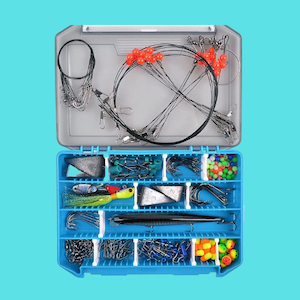The 9 Best Redfish Rigs (With Pictures)
UPDATED 03 NOVEMBER 2023
by Robert Ceran
Redfish are one of the most popular inshore species caught by anglers, and there are many good rigs for catching them.
However, effective rigging for redfish is more challenging than most people think, since redfish are found in a range of different habitats, and can be caught with a wide range of fishing techniques.
For example, if you want to catch big bull redfish in the surf with strong currents and waves, you’ll need a completely different setup than if you want to catch puppy redfish in a creek.
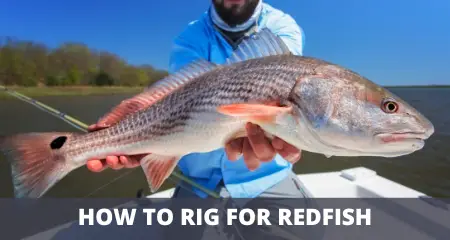
In this guide we’ll show you the best redfish rigs, how to set them up, and when you should use each of them for the best results.
How to rig for redfish
The 9 best rigs for redfish are:
- Fish finder rig
- Carolina rig
- Popping cork rig
- Slip bobber rig
- Fish finder rig with short leader
- Jig rig for redfish
- Swimbait rig
- Dropper loop rig
- Cannonball rig
Before we dive into the details and look at each of these rigs more closely, I’d like to point out that you probably only need 2 or 3 of these rigs for your purposes.
Which redfish fishing rigs are best to use for you depends on where you’re fishing, what size redfish you’re targeting, and how strong the fishing pressure is in your fishery.
So the best way to use this guide is to scan through all of the redfish setups first, and then zoom in on two or three that you’re most inspired by, and try them for yourself.
And once you’ve achieved success with the first few rigs, it’s always worth trying out some additional ones, to see if you can get even better results.
Fish finder rig
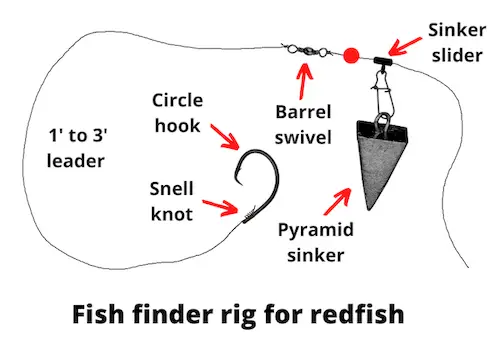
The fish finder rig is one of the most commonly used rigs for redfish, and is particularly useful for surf fishing or any other situations where you’re casting from the shore.
How to set it up: You’ll need the following components to set up a fish finder rig:
- Leader: 30 to 50 lb test monofilament or fluorocarbon
- Hook: 1/0 to 10/0 size circle hook or J-hook
- Weight: 1 to 3 oz pyramid sinker
- Swivel: 150 pound rated barrel swivel
- Sinker slide: Or snap swivel
Start by tying the leader to your hook with a snell knot or a single uni knot. Next measure out the length of leader that you want (I like to use 1 to 1.5 foot), and tie the other end of the leader to the barrel swivel.
Next, thread the sinker slide onto your main line (30 to 50 pound test braid), and then tie the main line to the other eye of the barrel swivel.
Finally, attach the snap of the sinker slider to the pyramid sinker, then bait the hook, and you’re ready to fish!
Instead of using a pyramid sinker, you can also use any other static sinker of your choice, such as a storm sinker or tongue sinker.
When to use it: This redfish rig setup is ideal for surf fishing, or when you’re fishing in strong current. Since it’s a relatively heavy red drum rig setup, this also makes it ideal for targeting big bull drum.
How to use it: The best way to use this red drum fishing rig is with cut bait or live bait. Just bait the hook, cast the rig out, and wait for a bite. Every now and then reel it in to make sure the hook is still baited, and that the rig didn’t get tangled up during the cast.
Carolina rig for redfish
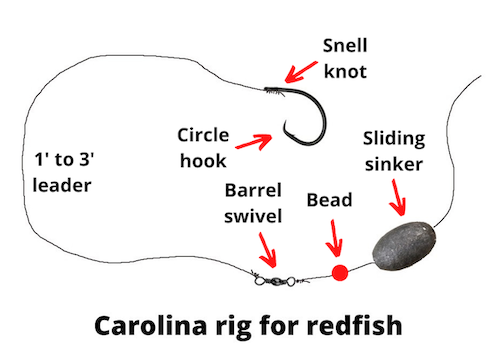
The Carolina rig is a more lightweight setup, and is ideal or inshore fishing for puppy red drum with a lightweight redfish tackle setup.
How to set it up: You’ll need the following components to set up a Carolina rig for red drum:
- Leader: 10 to 20 lb test monofilament or fluorocarbon
- Hook: #2 to 3/0 size circle hook or J-hook
- Weight: 1/4 to 2 oz sliding egg sinker
- Swivel: 100 pound rated barrel swivel
- Plastic bead
Tie the leader to your hook with a snell knot (or single uni knot). Measure out 1 to 3 feet of leader, and then tie the other end of the leader to the swivel.
Next, thread the egg sinker onto your main line (10 to 20 lb test braid), and then thread on the plastic bead. Finally, tie your main line to the other end of the swivel, and you’re ready to go!
When to use it: Since the Carolina rig is a relatively lightweight rig, it’s best suited for inshore fishing for puppy redfish in creeks, estuaries and piers, as well as for surf fishing.
The carolina rig performs best under low current conditions because the bullet sinker tends to get dragged across the bottom by a strong tide or current.
Alternatively, you can also use the carolina rig as a mobile rig that is dragged across the bottom by the current, and thereby covers more ground.
However, you need to be mindful of the bottom structure, since using the carolina rig this way results in a lot of snags.
How to use it: Bait your hook with cut bait, such as freshly cut blue crab, or with live bait, such as shrimp, mullet, croaker, or pinfish. Then cast out your rig and wait for a bite.
Popping cork rig

The popping cork rig is another favorite for inshore red drum fishing, and works best in shallow water under 5 feet depth.
How to set it up: You’ll need the following components to set up a popping cork rig:
- Popping cork of your choice
- Leader: 10 to 20 lb test fluoro or mono
- Hook: #2 to 2/0 circle hook
- Split shot: 1/16 to 1/8 oz split shot
Start by tying the end of your leader to the hook (either with a snell knot or single uni knot), and then measure out 1 to 4 feet of leader. The length of the leader should be chosen according to the depth of the water that you want to fish in.
Try to set the leader length so that your bait will be presented 6 inches to 1 foot off the bottom. If necessary, add a split shot weight about 3 inches above the hook, in order to keep your bait low in the water column.
Next, tie the other end of your leader to the bottom swivel of the popping cork (the bottom part is the one that has a weight on it). Finally, tie your main line to the other end of the popping cork, and you’re ready to fish.
When to use it: The popping cork rig is ideal for fishing in shallow water for redfish, including shallow creeks, seagrass flats, oyster beds, and mussel beds. Sometimes these locations are hard to fish with other rigs, but provide excellent redfish action.
How to use it: The best way to fish the popping cork rig is to bait the hook and then cast the rig out to a good spot.
Prime locations are nearshore drop offs next to creek edges or creek mouths, or oyster beds with feeding redfish. If you like, you can just wait for a bite, but another option is to retrieve your rig slowly with lots of pauses, which allows you to cover more ground.
Slip bobber rig
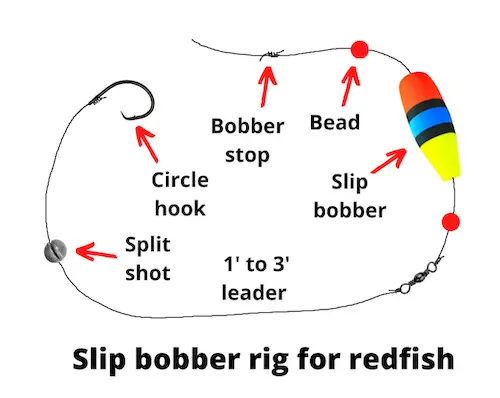
The slip bobber rig is a great option if you want to use float fishing for red drum in water that’s over 5 feet deep.
How to set it up: You’ll need the following components for this rig:
- Slip bobber (or sliding float)
- Bobber stopper
- Plastic beads
- Barrel swivel
- Hook: #2 to 5/0 size circle hook
- Leader: 10 to 20 lb test mono or fluoro
- Split shot weight: 1/16 to 1/2 oz split shot
Start by tying a circle hook to the leader, and then tie the other end of the leader to the swivel. The ideal leader length is usually around 1.5 feet, but you can also make it longer if you wish. Then pinch a split shot weight onto the line 4 to 5 inches above the hook.
Next, thread a bobber stopper onto your main line. A bobber stop consists of a short piece of thread tied in a nail knot, which you can slide up and down your line to adjust the fishing depth.
After you’ve put on the bobber stopper, thread a plastic bead onto the main line. This prevents the slip bobber from sliding over the bobber stop. Next, thread the slip bobber onto the line, and add another bead below it.
Finally, tie your main line to the other end of the swivel, and you’re good to go. Now you can easily adjust the depth at which your bait is presented in the water simply by sliding the bobber stopper up or down.
When to use it: The slip bobber rig is a great option for fishing in deeper water in creeks, harbors, or piers, where a popping cork won’t allow you to fish deep enough, since it’s fixed to the line. Using a slip bobber is a great way to drift your bait along the edges of creeks with the current.
How to use it: Figure the depth of the water in which you want to fish, and then set the depth of your slip bobber rig to present your bait with a foot or two of the bottom.
You can bait the hook with either live bait or cut bait, and then cast it out to promising locations. Another option is to use a jig head instead of a circle hook, which will help to keep your bait close to the bottom.
Fish finder rig with short leader

This variation of the fish finder rig is becoming increasingly popular for surf fishing, since it performs better for longer casts, compared to the ‘standard’ version.
How to set it up: Use the same components as for a regular fish finder rig (see above), and follow the same steps to set it up.
However, instead of tying a 1 to 3 foot leader, use a heavier leader material and make sure that it’s just 1 to 2 inches long.
Some anglers like to use a plastic bead between the sinker slide and the swivel, since this protects the knot on the swivel from being chafed.
This is optional, however, since many other fishermen don’t use a bead, and claim they don’t see any difference.
When to use it: This red drum fishing irg is the best option to use when you need to cast over very long distances in order to reach the fish.
This is most often the case on shallow beaches, where you need to cast a hundred feet or more.
How to use it: Bait the hook with cut bait, such as cut crab or fish, and cast out the rig from the beach.
Then wait until a fish eats the bait, and every now and again reel in the rig to re-bait the hook. Live bait is not a good option, since it will tend to be ripped off the hook when you’re doing long casts.
Redfish jig setup
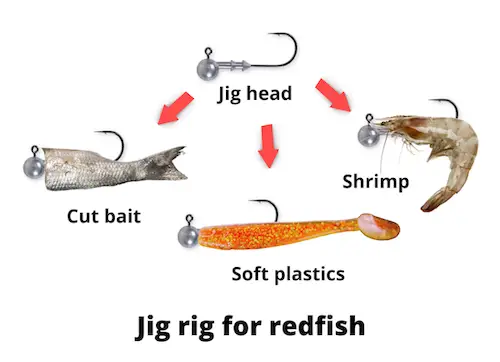
The jig rig is not only one the simplest red fish rig, but is also incredibly versatile, and can be used with a wide variety of baits and fishing techniques.
How to set it up: The easiest option is to tie a jig head directly to your main line. However, if you like, you can also use a monofilament or fluorocarbon shock leader, which might be helpful in clear water.
Another option is to use a jig head rigged under a bobber (such as a popping cork or slip bobber), which combines the strengths of two rigs into one setup, and allows you to fish over cover without getting snagged.
When to use it: This redfish setup can be used in any situations where redfish are found close to shore, such as piers, jetties, or creeks, or when you’re fishing from a boat. But keep in mind that a jig head tends to get snagged in cover, so be mindful of that when you use it.
How to use it: Bait your jig head with any of a wide variety of baits, including soft plastic baits, cut bait, and live bait. Then cast it out and let it sink to the bottom, followed by retrieving the rig by hopping the jig head along the bottom in small jerks.
Swimbait rig
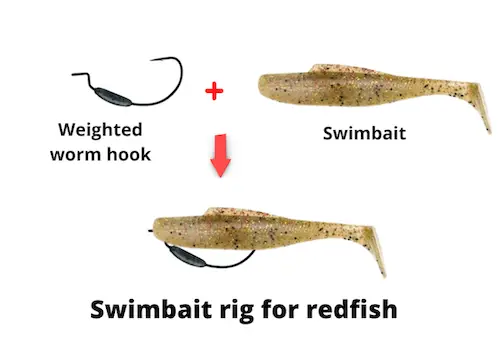
A swimbait rig is similar to a jig head rig, but is specifically designed to be used with soft plastic swimbaits, and comes with the advantage of weedless rigging for redfish.
How to set it up: Start by tying a weighted worm hook to your main line (or to a shock leader).
Then thread a soft plastic swimbait onto the hook so that the head of the swimbait is secured on the bend at the top of the hook shank, and the point of the hook is inserted into the belly of the swimbait.
This setup hides the hook point inside the swimbait, which is a weedless setup that allows you to fish for redfish on spartina grass flats without getting snagged.
When to use it: Similar to the jig head rig, the swimbait rig is a great option when casting for redfish close to shore, or from a boat. I like to use this rig around piers and docks, as well as in creeks.
How to use it: Simply cast out your swimbait rig and then retrieve it in small jerks close to the bottom.
Dropper loop rig
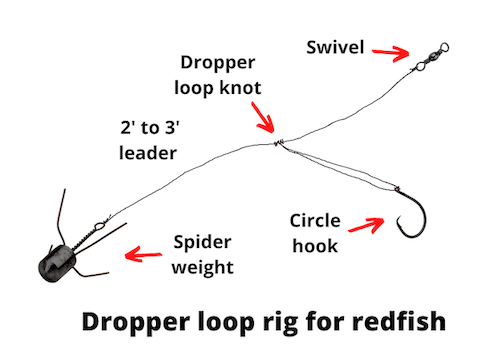
The dropper loop rig is a great option when fishing for redfish in strong tides or currents.
How to set it up: You’ll need the following components for this rig:
- Spider weight
- Barrel swivel
- Leader: 30 to 50 lb test monofilament or fluorocarbon
- Hook: 4/0 to 10/ circle hook
First tie your leader line to the spider weight with a single uni knot. Then measure out about 3 feet of leader line, and tie the other end to the barrel swivel. Next, you need to create a dropper loop more or less in the middle of the leader.
Tying a dropper loop knot is very easy, but the best way to figure out how to do this is by watching a demonstration, which you can do in this video demonstration of how to tie a dropper loop.
Once you’re done, you can then easily attach a circle hook to the end of the dropper loop by first threading the loop through the eye of the hook, and then passing it over the end of the hook and cinching it down.
When to use it: The dropper loop rig is great for fishing in strong currents, since the weight is located at the end of the line, and thus provides a stable anchor point for the rig.
Also, if you tie this rig with a spider weight, the metal arms of the weight will dig into the bottom when it is dragged along by a heavy current, thus providing even more stability.
How to use it: Bait the hook with natural bait or cut bait, and cast it out to a promising location. Then place your rod in a rod holder and wait for bites.
When a redfish takes the bait, it will hook itself, and the circle hook is almost always set in the corner of the mouth, which is ideal for catch-and-release fishing.
Cannonball rig
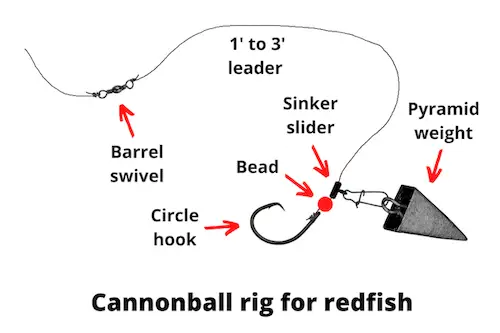
The cannonball rig is similar to the fish finder rig, but with the key difference that the sinker slider rides on the leader, and not on the main line.
How to set it up: Use the same components as for the fish finder rig. Start by tying the hook to the leader and then measure out 1 to 3 feet of leader line. Next, thread a plastic bead onto the leader line, followed by the slider sinker attached to a pyramid weight.
Finally, tie the leader to the barrel swivel, and then tie your main line to the other end of the barrel swivel, and you’re ready to fish.
When to use it: The cannonball rig is even better than the fish finder rig with a short leader when it comes to maximizing casting distance, which makes the cannonball rig the best setup for redfish in locations where you have to cast far out into the surf.
How to use it: Bait your hook with cut bait or natural baits and cast out the rig. Then place your rod in a sand spike and wait for a big red to bite.
How to rig shrimp for redfish
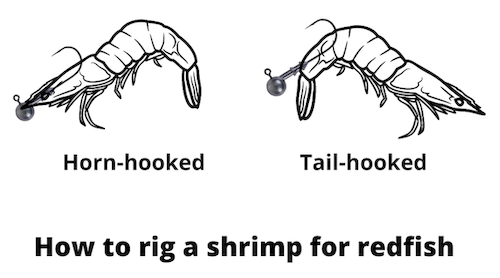
Shrimp are one of the best baits for redfish, and can be used either live or dead. And while there are many different ways of rigging a shrimp for redfish, the image above shows the two most common ways to do this.
If you choose the option of horn-hooking the shrimp, this is great for drift fishing with a circle hook or jig head rigged under a float. However, if you want to cast and retrieve the shrimp, this setup is not ideal, since the shrimp will tend to be torn off during the cast.
Tail-hooking the shrimp is best for casting and retrieving, since the shrimp stays on the hook much better than with horn-hooking. You can also do this with an artificial shrimp.
Using lures for redfish
Lures can also be highly effective for catching redfish, and if you’re a bass angler, you’ll be glad to hear that many of the lures that catch largemouth bass also catch redfish.
Hard baits
You can use a wide variety of hardbaits, such as crankbaits, jerkbaits, plugs, and heavy spoons catch fish very effectively.
The best way to fish these redfish lures is to cast and retrieve them over shallow sandbars, mud flats, shell bars, and grass flats. You can also cast them along rock jetties and creek edges in coastal areas.
Soft plastic baits
Another great lure type to use for redfish are soft plastics, including paddle tail lures, flukes and plastic minnows (such as the Zoom Salty Super Fluke, Berkley Gulp Minnow, Z-Man Diezel Minnow, or the Matrix shad).
You can rig these with a jig head or a worm hook (as shown for the swimbait rig above), and just cast your soft plastic lures to promising spots, or use vertical jigging from a boat.
Since redfish rely heavily on their sense of smell to find prey, another great option is to use liquid scents to make your soft plastics more attractive (which is effective in dirty water). Personally, I like the fish attractants from Pro-Cure for this.
A second way to take advantage of the keen sense of smell of redfish is by chumming with crushed crabs in order to attract redfish schools.
And if you do find a redfish school, use your trolling motor to stay locked in that position, and make sure to record a waypoint on your chart plotter for future reference.
What is the best rig for redfish?
The three best rigs for redfish are the fish finder rig, the popping cork rig, and the carolina rig. With that being said, choosing the best rig for red drum depends on where you’re fishing, and whether you’re targeting puppy red drum or trophy size redfish.
Best bull redfish rigs
Since big redfish can grow to enormous sizes north of 50 pounds, it’s necessary to use heavy redfish tackle and heavy duty rigs when targeting them. The best rigs for bull reds are the fish finder rig, dropper loop rig, and cannonball rig.
All of these rigs are designed to perform well in deep waters and in strong currents, which is exactly what you need in order to catch giant bull redfish.
If you’re targeting big redfish in deep creeks, you can also use a Carolina rig or a slip bobber rig, but keep in mind that you’ll need to use heavier lines and bigger hooks than you would for puppy redfish.
What are the best redfish rigs for surf fishing?
The best red fish rigs for surf fishing are the fish finder bottom rig, the fish finder rig with a short leader, and the cannonball rig.
In fact all of these rigs were designed for surf fishing, and which one you choose depends on how far you’ll need to cast the rig to reach the redfish feeding zones.
The cannonball rig has the best performance for long distance casting, followed by the fish finder rig with a short leader.
If you’re based in Florida and planning to go redfish fishing, check out our article on Redfish size limit in Florida.
What are the best redfish rigs for live bait?
The best red drum rigs for live bait are the carolina rig, the popping cork rig, the slip bobber rig, and the jig rig.
Each of these redfish bait rigs is great for fishing with live shrimp, live finger mullet, croaker or pinfish.
If you want to match the hatch as much as possible with your choice of redfish bait, check out our article on what do Redfish like to eat?
What are the best redfish rigs for pier fishing?
The best redfish rigs for pier fishing are the carolina rig, the slip bobber rig, and the jig rig.
Since pier fishing involves fishing in deep water, you need to use rigs that can effectively place your baited hook in the strike zone close to the bottom.
If there is a strong current at the pier where you’re fishing, another great option is the dropper loop rig for bottom fishing.
You can use this rig with either a pyramid sinker or a spider sinker, in order to make sure your rig isn’t dragged along the bottom.
Final remarks
This concludes our guide to the most important redfish rig setups. Hopefully you’ve found a few rigs that’ll help you catch more redfish.
If you’re based in Florida, Virginia, Alabama, or throughout the Gulf Coast, most of these rigs are ideal for catching redfish in your waters.
And it’s worth mentioning that many of these rigs also work well for other inshore saltwater fish, such as speckled trout, snook and flounder.
Finally, if you’re planning to eat the redfish you catch, check out our article on Redfish vs red snapper taste.

